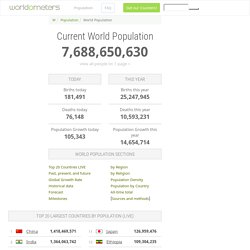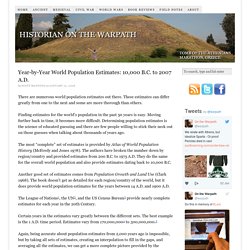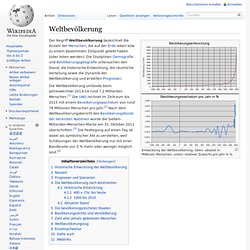

Worldometers - real time world statistics. World Population Clock: 7 Billion People. World Population: Past, Present, and Future (move and expand the bar at the bottom of the chart to navigate through time) The chart above illustrates how world population has changed throughout history.

View the full tabulated data. At the dawn of agriculture, about 8000 B.C., the population of the world was approximately 5 million. Over the 8,000-year period up to 1 A.D. it grew to 200 million (some estimate 300 million or even 600, suggesting how imprecise population estimates of early historical periods can be), with a growth rate of under 0.05% per year. A tremendous change occurred with the industrial revolution: whereas it had taken all of human history until around 1800 for world population to reach one billion, the second billion was achieved in only 130 years (1930), the third billion in 30 years (1960), the fourth billion in 15 years (1974), and the fifth billion in only 13 years (1987).
World. World Population Application. World Population Map Statistics Graph Most Populated Cities. Population Map Statistics Graph Most Populated Cities. The AfriPop Project. GeoHive - Population Statistics. Worldmapper: The world as you've never seen it before. World Population Clock. This Javascript allows the page in IE to resize to the minimum width of 853 pixels and no less.

You are here: Census.gov › U.S. and World Population Clocks › World PopClock Skip top of page navigation According to the U.S. Census Bureau, the total population of the World, projected to 09/09/14 at 14:42 UTC (EST+5) is. PopulationMondiale.com - World population clock : suivez l'évolution de la population du Monde en direct ! World Population. Stiftung Weltbevölkerung: Weltbevölkerungsuhr.
Office of Population Research, Princeton University. Population Counter - Country Index. Bettina Speckmann - Cartograms - FIFA World Cup. Year-by-Year World Population Estimates: 10,000 B.C. to 2007 A.D. There are numerous world population estimates out there.

These estimates can differ greatly from one to the next and some are more thorough than others. Finding estimates for the world’s population in the past 50 years is easy. Moving further back in time, it becomes more difficult. Determining population estimates is the science of educated guessing and there are few people willing to stick their neck out on those guesses when talking about thousands of years ago. The most “complete” set of estimates is provided by Atlas of World Population History (McEvedy and Jones 1978). Another good set of estimates comes from Population Growth and Land Use (Clark 1968).
The League of Nations, the UN, and the US Census Bureau provide nearly complete estimates for each year in the 20th Century. Certain years in the estimates vary greatly between the different sets. The following chart is comprised of 12 sets of estimates. Filling in the Gaps ). The simplest example can be seen using Microsoft Excel. . Weltbevölkerung. Entwicklung der Weltbevölkerung.

Oben: absolut in Millionen Menschen; unten: relativer Zuwachs pro Jahr in % Der Begriff Weltbevölkerung bezeichnet die Anzahl der Menschen, die auf der Erde leben bzw. zu einem bestimmten Zeitpunkt gelebt haben (oder leben werden). Die Disziplinen Demografie und Bevölkerungsgeografie untersuchen den Stand, die historische Entwicklung, die räumliche Verteilung sowie die Dynamik der Weltbevölkerung und erstellen Prognosen. Die Weltbevölkerung umfasste beim Jahreswechsel 2013/14 rund 7,2 Milliarden Menschen.[1] Die UNO rechnet im Zeitraum bis 2015 mit einem Bevölkerungswachstum von rund 78 Millionen Menschen pro Jahr.[2] Nach dem Weltbevölkerungsbericht des Bevölkerungsfonds der Vereinten Nationen wurde die Sieben-Milliarden-Menschen-Marke am 31. Oktober 2011 überschritten.[3] Die Festlegung auf einen Tag ist dabei als symbolischer Akt zu verstehen, weil Schätzungen der Weltbevölkerung nur mit einer Bandbreite von 5 % mehr oder weniger möglich sind.[4]
World population. World population estimates from 1800 to 2100, based on "high", "medium" and "low" United Nations projections in 2010 (colored red, orange and green) and US Census Bureau historical estimates (in black).

Actual recorded population figures are colored in blue. According to the highest estimate, the world population may rise to 16 billion by 2100; according to the lowest estimate, it may decline to 6 billion. The world population is the total number of living humans on Earth. As of March 26, 2014, it is estimated to number 7.156 billion by the United States Census Bureau (USCB).[1] The USCB estimates that the world population exceeded 7 billion on March 12, 2012.[2] According to a separate estimate by the United Nations Population Fund, it reached this milestone on October 31, 2011.[3][4][5] Population by region[edit] Six of Earth's seven continents are permanently inhabited on a large scale.
Population by continent[edit] Statistiken.